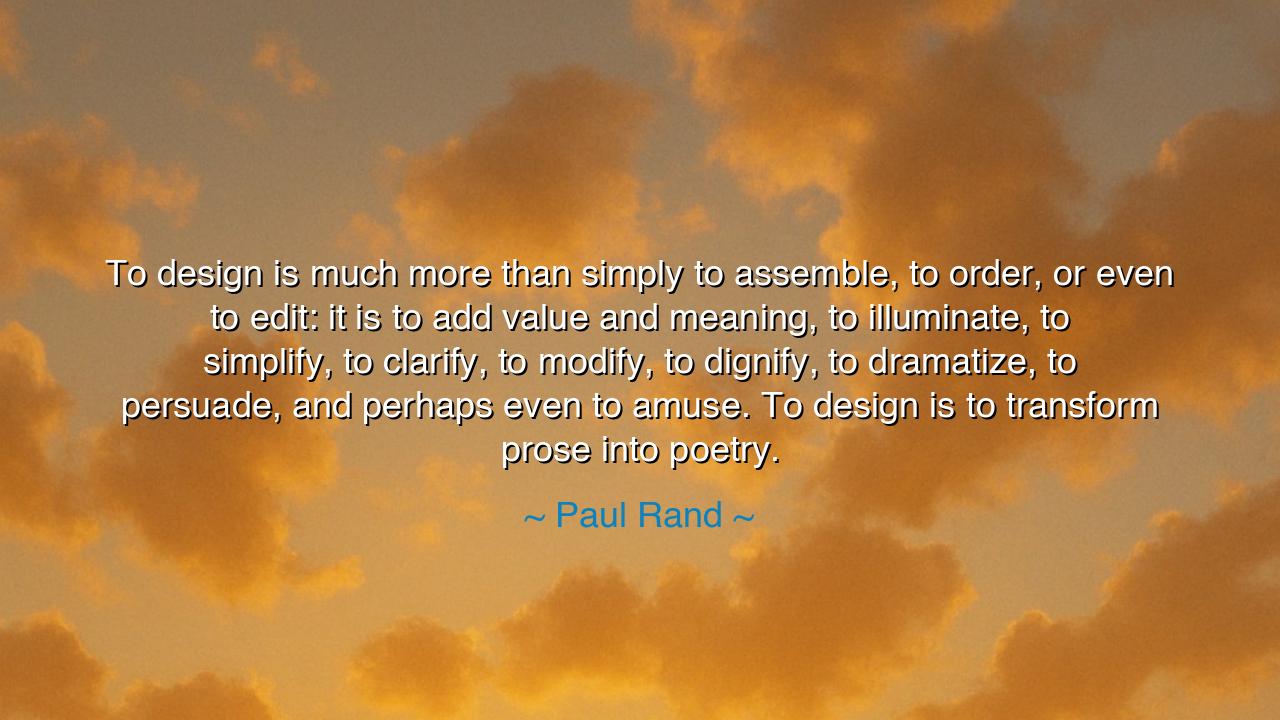
To design is much more than simply to assemble, to order, or even
To design is much more than simply to assemble, to order, or even to edit: it is to add value and meaning, to illuminate, to simplify, to clarify, to modify, to dignify, to dramatize, to persuade, and perhaps even to amuse. To design is to transform prose into poetry.






“To design is much more than simply to assemble, to order, or even to edit: it is to add value and meaning, to illuminate, to simplify, to clarify, to modify, to dignify, to dramatize, to persuade, and perhaps even to amuse. To design is to transform prose into poetry.” – Paul Rand
Listen well, O creators of form and seekers of beauty, to the words of Paul Rand, the great philosopher of design and artist of clarity. In this declaration, he speaks not as a craftsman of surfaces but as a poet of purpose. “To design is much more than simply to assemble, to order, or even to edit,” he begins, reminding us that design is not the mechanical act of arranging elements, but the divine art of giving them life and meaning. He teaches that the designer’s hand must do more than construct—it must illuminate, clarify, and inspire. To design, he says, is not to decorate the world, but to elevate it.
For Rand, whose work defined the language of modern identity—the logos of IBM, ABC, UPS, and others—design was never mere aesthetics. It was communication made noble, the marriage of logic and emotion. Each line, each curve, each color carried intent. When he says that design “adds value and meaning,” he speaks of a sacred process: the transformation of chaos into coherence, of confusion into understanding. The true designer does not assemble the world as it is, but reveals what it longs to become.
This philosophy was born in the heart of the twentieth century, when the world was learning to balance function and art. The machines of industry had changed the world, yet their creations lacked soul. Rand saw that the task of the designer was to restore humanity to modernity, to make the useful also beautiful, and the beautiful also clear. In his hands, design became a language of grace—a way to dignify even the humblest object, to remind people that intelligence could live within simplicity. His words carry this truth: that design is empathy made visible, a bridge between thought and feeling.
Consider, O listener, the tale of Steve Jobs and the creation of Apple’s first products, a story that draws its spirit directly from Rand’s teachings. Jobs, who admired Rand deeply, believed that technology must not only function but delight. The devices he built—sleek, simple, luminous—were designed to invite the human touch. Each one was an argument, a persuasion, a drama in metal and glass. Like Rand, Jobs understood that design is not merely assembly—it is storytelling. The way a button clicks, the way light gleams off a surface, the way a logo sits upon a screen—these are not accidents, but choices that shape how people feel. The designer, then, is not a builder of objects, but a composer of experience.
Rand’s words carry another truth: to design is to simplify without diminishing. The designer’s mission is not to strip away beauty, but to distill it—to reveal its essence. “To design is to clarify,” he writes, and in this he captures the wisdom of the ancients. For clarity is a kind of honesty; it allows truth to shine without distortion. The architect who builds a temple, the calligrapher who draws a single stroke, the writer who shapes a sentence—all are designers, reducing the unnecessary until only meaning remains. This act, noble and disciplined, transforms prose into poetry.
Yet Rand reminds us, too, that design must do more than serve reason—it must move the heart. To design, he says, is also to dignify, dramatize, persuade, and amuse. In these words lies the secret of all great art: that beauty is not a luxury, but a necessity. A world without joy, without wonder, without laughter, becomes mechanical and dead. The true designer, then, is not only a craftsman, but a humanist, one who creates to uplift the spirit and remind us that even the most ordinary things can speak with the voice of art.
So, O maker and dreamer, take heed of Paul Rand’s wisdom: your task is not to assemble, but to awaken. Whatever you create—be it a drawing, a building, a sentence, or a life—let it carry purpose, clarity, and grace. Ask not only, “Does it work?” but also, “Does it mean something?” For meaning is the breath of creation, and without it, all design is hollow.
And thus, as Paul Rand teaches, the act of design is the act of transformation. To design is to turn the ordinary into the extraordinary, to elevate function into feeling, and to reveal poetry in all that is made by human hands. Let every stroke, every choice, every creation bear this spirit: that through design, we do not merely arrange the world—we give it voice, dignity, and soul.






AAdministratorAdministrator
Welcome, honored guests. Please leave a comment, we will respond soon